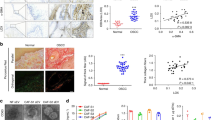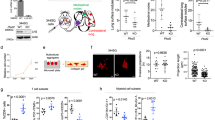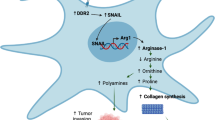Abstract
Inactivation of the von Hippel–Lindau (VHL) tumor suppressor gene predisposes to vascular tumor formation in several organs. VHL regulates two evolutionary conserved pathways: the targeting of hydroxylated hypoxia-inducible factor-α (HIF-α) for proteasomal degradation and the remodeling of extracellular matrix (ECM). The biochemical mechanisms of the ECM assembly pathway remain poorly defined. Here, we provide evidence supporting a biochemical role for VHL in ECM assembly. We show that VHL directly binds to the collagen IV alpha 2 (COL4A2) chain and that this interaction is necessary for its assembly into the ECM. The VHL–COL4A2 interaction is dependent on endoplasmic reticulum (ER)-mediated COL4A2 hydroxylation and independent of cytosolic, hypoxia regulated HIF-α-modifying enzymes. We find that the N-terminal tail of COL4A2 protrudes from the ER lumen into the cytosol where it is bound by VHL. Failure of VHL to interact with COL4A2 correlates with loss of collagen IV network formation in vitro and collagen IV remodeling in vivo. Our data suggest a HIF-α-independent role for the VHL–COL4A2 interaction in suppression of angiogenic tumor formation through collagen IV network assembly.
This is a preview of subscription content, access via your institution
Access options
Subscribe to this journal
Receive 50 print issues and online access
$259.00 per year
only $5.18 per issue
Buy this article
- Purchase on Springer Link
- Instant access to full article PDF
Prices may be subject to local taxes which are calculated during checkout






Similar content being viewed by others
References
Barry RE, Krek W . (2004). The von Hippel–Lindau tumour suppressor: a multi-faceted inhibitor of tumourigenesis. Trends Mol Med 10: 466–472.
Bishop T, Lau KW, Epstein AC, Kim SK, Jiang M, O'Rourke D et al. (2004). Genetic analysis of pathways regulated by the von Hippel–Lindau tumor suppressor in Caenorhabditis elegans. PLoS Biol 2: e289.
Clifford SC, Cockman ME, Smallwood AC, Mole DR, Woodward ER, Maxwell PH et al. (2001). Contrasting effects on HIF-α-1alpha regulation by disease-causing pVHL mutations correlate with patterns of tumourigenesis in von Hippel–Lindau disease. Hum Mol Genet 10: 1029–1038.
Epstein AC, Gleadle JM, McNeill LA, Hewitson KS, O'Rourke J, Mole DR et al. (2001). C. elegans EGL-9 and mammalian homologs define a family of dioxygenases that regulate HIF-α by prolyl hydroxylation. Cell 107: 43–54.
Esteban-Barragan MA, Avila P, Alvarez-Tejado M, Gutierrez MD, Garcia-Pardo A, Sanchez-Madrid F et al. (2002). Role of the von Hippel–Lindau tumor suppressor gene in the formation of beta1-integrin fibrillar adhesions. Cancer Res 62: 2929–2936.
Grosfeld A, Stolze IP, Cockman ME, Pugh CW, Edelmann M, Kessler B et al. (2007). Interaction of hydroxylated collagen IV with the von Hippel–Lindau tumor suppressor. J Biol Chem 282: 13264–13269.
Handsley MM, Edwards DR . (2005). Metalloproteinases and their inhibitors in tumor angiogenesis. Int J Cancer 115: 849–860.
Hoffman MA, Ohh M, Yang H, Klco JM, Ivan M, Kaelin Jr WG . (2001). von Hippel–Lindau protein mutants linked to type 2C VHL disease preserve the ability to downregulate HIF-α. Hum Mol Genet 10: 1019–1027.
Iwai K, Yamanaka K, Kamura T, Minato N, Conaway RC, Conaway JW et al. (1999). Identification of the von Hippel–lindau tumor-suppressor protein as part of an active E3 ubiquitin ligase complex. Proc Natl Acad Sci USA 96: 12436–12441.
Kaelin Jr WG . (2002). Molecular basis of the VHL hereditary cancer syndrome. Nat Rev Cancer 2: 673–682.
Kondo K, Klco J, Nakamura E, Lechpammer M, Kaelin Jr WG . (2002). Inhibition of HIF-α is necessary for tumor suppression by the von Hippel–Lindau protein. Cancer Cell 1: 237–246.
Kurban G, Hudon V, Duplan E, Ohh M, Pause A . (2006). Characterization of a von Hippel–Lindau pathway involved in extracellular matrix remodeling, cell invasion, and angiogenesis. Cancer Res 66: 1313–1319.
Min JH, Yang H, Ivan M, Gertler F, Kaelin Jr WG, Pavletich NP . (2002). Structure of an HIF-α-1alpha–pVHL complex: hydroxyproline recognition in signaling. Science 296: 1886–1889.
Ohh M, Yauch RL, Lonergan KM, Whaley JM, Stemmer-Rachamimov AO, Louis DN et al. (1998). The von Hippel–Lindau tumor suppressor protein is required for proper assembly of an extracellular fibronectin matrix. Mol Cell 1: 959–968.
Prockop DJ, Kivirikko KI . (1995). Collagens: molecular biology, diseases, and potentials for therapy. Annu Rev Biochem 64: 403–434.
Raval RR, Lau KW, Tran MG, Sowter HM, Mandriota SJ, Li JL et al. (2005). Contrasting properties of hypoxia-inducible factor 1 (HIF-α-1) and HIF-α-2 in von Hippel–Lindau-associated renal cell carcinoma. Mol Cell Biol 25: 5675–5686.
Schoenfeld AR, Davidowitz EJ, Burk RD . (2001). Endoplasmic reticulum/cytosolic localization of von Hippel–Lindau gene products is mediated by a 64-amino acid region. Int J Cancer 91: 457–467.
Semenza GL . (2003). Targeting HIF-α-1 for cancer therapy. Nat Rev Cancer 3: 721–732.
Soder S, Poschl E . (2004). The NC1 domain of human collagen IV is necessary to initiate triple helix formation. Biochem Biophys Res Commun 325: 276–280.
Stickle NH, Chung J, Klco JM, Hill RP, Kaelin Jr WG, Ohh M . (2004). pVHL modification by NEDD8 is required for fibronectin matrix assembly and suppression of tumor development. Mol Cell Biol 24: 3251–3261.
Zimmer M, Doucette D, Siddiqui N, Iliopoulos O . (2004). Inhibition of hypoxia-inducible factor is sufficient for growth suppression of VHL−/− tumors. Mol Cancer Res 2: 89–95.
Author information
Authors and Affiliations
Corresponding author
Additional information
Supplementary Information accompanies the paper on the Oncogene website (http://www.nature.com/onc).
Supplementary information
Rights and permissions
About this article
Cite this article
Kurban, G., Duplan, E., Ramlal, N. et al. Collagen matrix assembly is driven by the interaction of von Hippel–Lindau tumor suppressor protein with hydroxylated collagen IV alpha 2. Oncogene 27, 1004–1012 (2008). https://doi.org/10.1038/sj.onc.1210709
Received:
Revised:
Accepted:
Published:
Issue Date:
DOI: https://doi.org/10.1038/sj.onc.1210709
Keywords
This article is cited by
-
Impaired oxygen-sensitive regulation of mitochondrial biogenesis within the von Hippel–Lindau syndrome
Nature Metabolism (2022)
-
Clear cell renal cell carcinoma ontogeny and mechanisms of lethality
Nature Reviews Nephrology (2021)
-
The role of collagen in cancer: from bench to bedside
Journal of Translational Medicine (2019)
-
A pan-cancer perspective of matrix metalloproteases (MMP) gene expression profile and their diagnostic/prognostic potential
BMC Cancer (2019)
-
Mechanisms of hypoxia signalling: new implications for nephrology
Nature Reviews Nephrology (2019)



